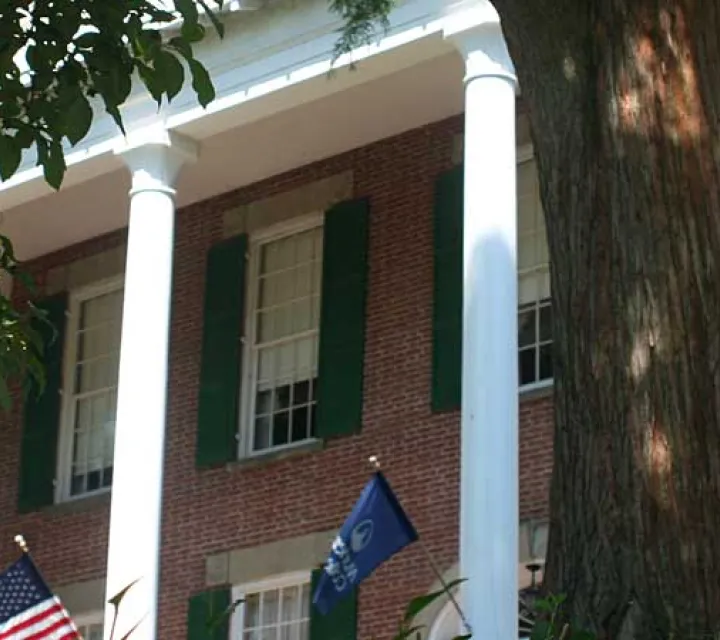Throughout its entire history, Marietta College has supplied housing for its presidents.
“In the winter of 1834-35, the house of Mr. Billy Todd, on Fourth street [sic], not far from Putnam, was purchased. It was used until 1870 as the president’s house, and for students’ rooms till 1874, when it was taken down,” describes Marietta’s third president, Israel Ward Andrews, in Arthur Beach’s A Pioneer College.
The brick house was located near the Fourth Street entrance of campus, across from where the Sigma Kappa house currently stands. It served as the President’s House for more than 30 years.
A decade after Erwin Hall was constructed, the College built a new home for the president. The 10-bedroom house, completed in 1870 for $8,000, was located on Fifth Street across from the southwest corner of Mound Cemetery.
“It was later separated into three residences and numbered 323, 325 and 327 Fifth Street,” writes Dan McGrew in the College’s second history book, In the Various Branches of Useful Knowledge.
In 1892, the College purchased the Charles Butler Wells estate for $4,500 to serve as the President’s House.
“An attractive, inviting two-story frame, it occupied part of a sizable open plateau that came to a point overlooking the Fifth and Butler intersection, a bit of a bluff lost to view when the area was excavated to a considerable depth for Gilman Student Center,” McGrew writes.
Two major events happened that affected Marietta College in 1936: Dr. Edward Smith Parsons, Marietta’s eighth president, retired from office; and longtime supporter John Mills Jr., son of Col. John Mills, died. He had lived in the house at 301 Fifth Street for 90 years.
The house at 301 Fifth Street has held a bird’s eye view of Marietta College since before the institution received its charter from the state of Ohio in 1835.
Built in 1822 for Henry Wilcox, the city’s eighth postmaster, the Federal style structure was acquired in 1837 by Col. John Mills, a local banker and businessman. Col. Mills was the first treasurer of Marietta College, a post he held from 1835 until 1850. Mills’ two sons, John Jr. (Class of 1867) and W.W. Mills (Class of 1871) were bequeathed the house after their father’s death in 1882. Like their father, both sons were longtime trustees of the College and provided a great deal of guidance and life-saving financial support, particularly during lean times.
Acquiring the Wilcox-Mills House would allow the College to accomplish two things: provide a historic home for future presidents, and allow the former President’s House, which would be renamed “Parsons Hall,” to serve as a much-needed student center, in addition to being the campus post office and bookstore until it burned down in 1949.
Though the College had the opportunity to acquire the historic house, the timing could not be worse. Despite having a record number of students — about 390 — enrolled, the College and the country were still in the grips of the Great Depression. But with the help of another notable alumnus — Dallas oil magnate and Marietta College Trustee Edwy R. Brown, Class of 1894, a few other gifts and a bank loan, the College managed to come up with the $25,000 asking price for the Wilcox-Mills House. Brown’s estate later bequeathed $300,000 to the College to found its Petroleum Engineering and Geology Department.
All but one Marietta College president has occupied the Wilcox-Mills House since it was purchased. President Draper Talman Schoonover took over the College’s leadership in 1942 after President Harry Kelso Eversull, an ordained minister, had a calling to leave the post 20 days after the Pearl Harbor attacks “to return to religious work for which I have been trained and in which my primary interests lie.”
Schoonover had served the College since 1907 when he was asked to stand in as acting president for a year between the Parsons and Eversull transition, so he was the obvious choice for president when Eversull left. Because his family already had a house in Marietta, he declined the College’s on-campus accommodation. This enabled the College to use the historic structure to house women students who were displaced from Dorothy Webster Hall due to the need to house cadets and officers of the 25th College Training Detachment (Air Crew) of the U.S. Army Air Corps.
Once World War II ended and William Shimer took office as Marietta’s 10th president, the College began renovating the Wilcox-Mills House to better suit its residents. Some of its more notable renovations include sandblasting white paint from the brick exterior, adding a new kitchen to the back of the house, and, most recently, installing energy efficient heating and air conditioning, along with other historically-accurate aesthetic improvements.
Prior to the College acquiring the Wilcox-Mills House, one of the major additions to the property included the street wall and curved iron railing along the Putnam Street entrance. Both were designed by Rufus Erastus Harte, who was architect of Erwin Hall. The President’s House was added to the National Register of Historic Places on April 13, 1973, which lists Count de Grasse Bonney as the designer of the original 1822 structure.
